New Internet Now Allows People to Interact on Video

This thing just happened. It’s called VYou. Basically it’s non-live Chatroulette without any dudes masturbating. (Yet.) We are testing it out ourselves to see if it has any practical uses whatsoever. Really though, all I can think when I look at it is: oh gosh, wait till the gays get their hands on this.
The Rally to Restore Sanity in Pictures: Arianna's Bus to Magicland
by Stephen Kosloff

Did you have things to do this weekend? Such as go to work, or perhaps rally to help get out the vote in tomorrow’s election, for instance? If you didn’t make it down to D.C. for the non-political political comedian rally, our photographer Stephen Kosloff shows you what you missed — including Arianna Huffington learning for presumably the first time about transportation by bus. In the immortal words of the Huff herself, let the [PICTURES!] [SLIDESHOW!] begin!
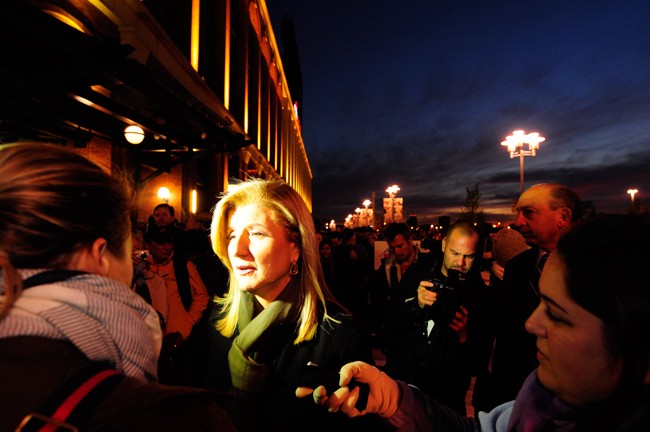
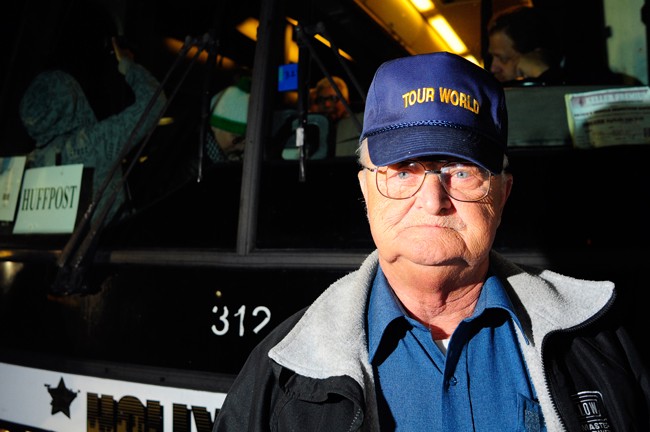


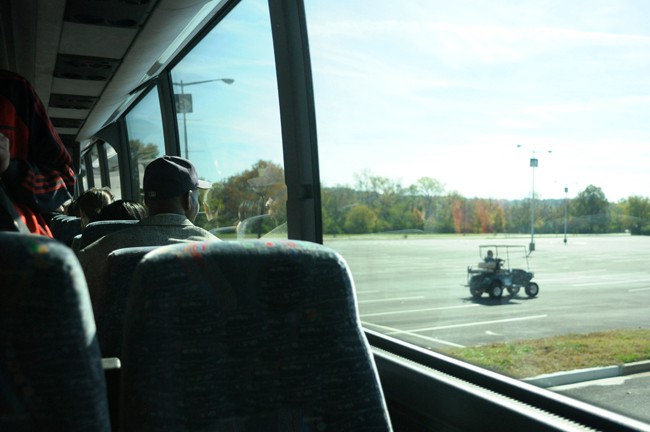
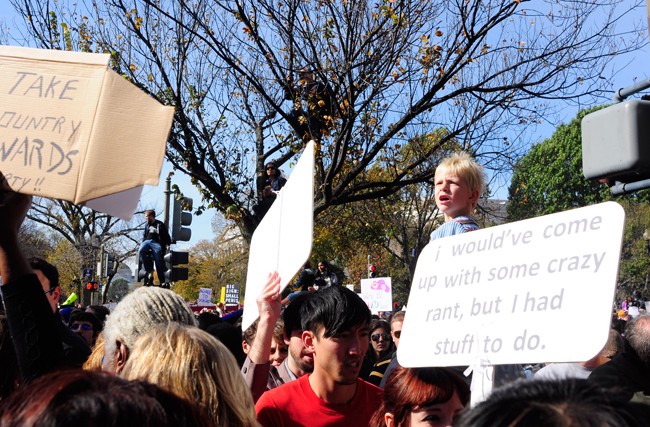
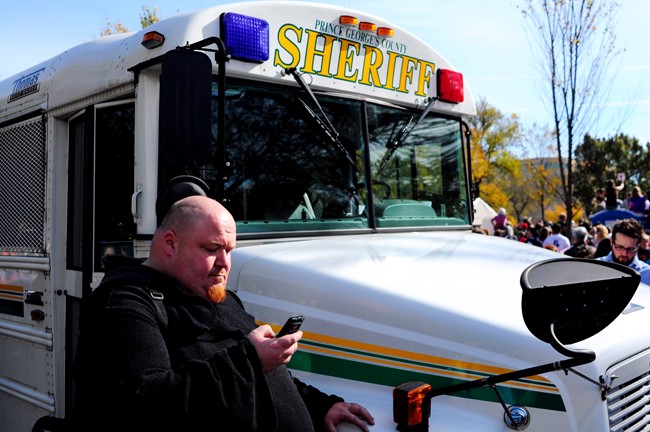
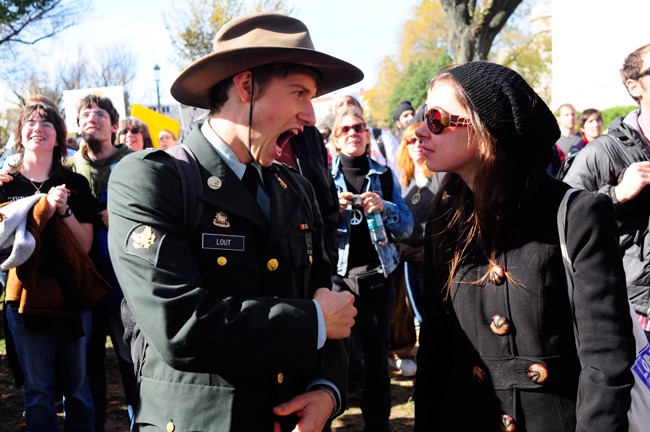


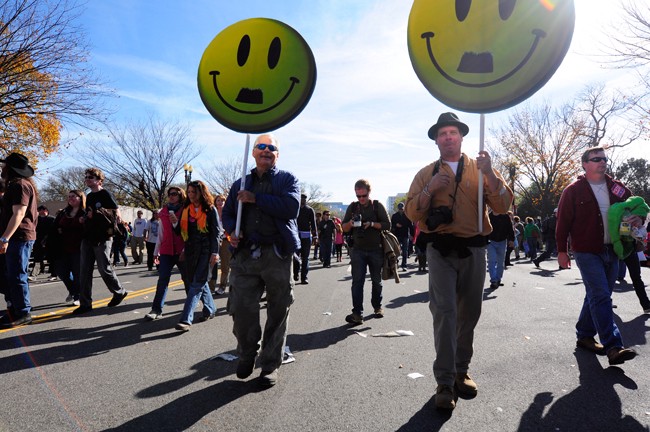

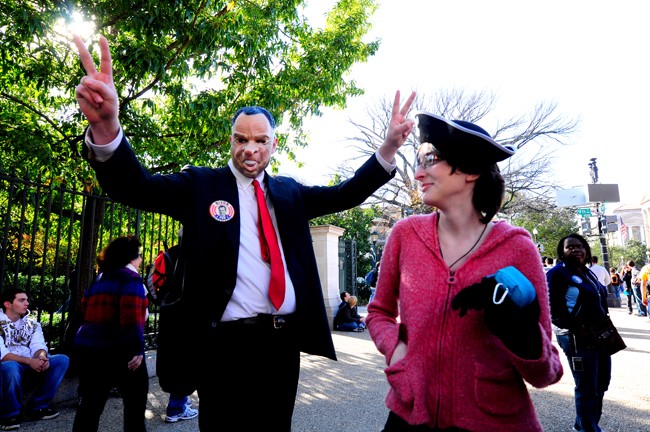
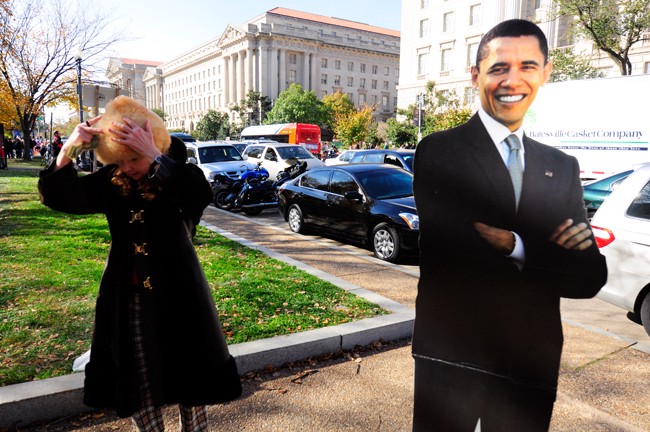

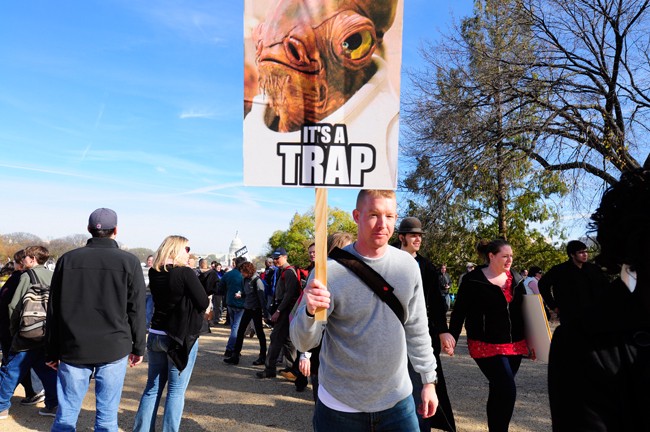

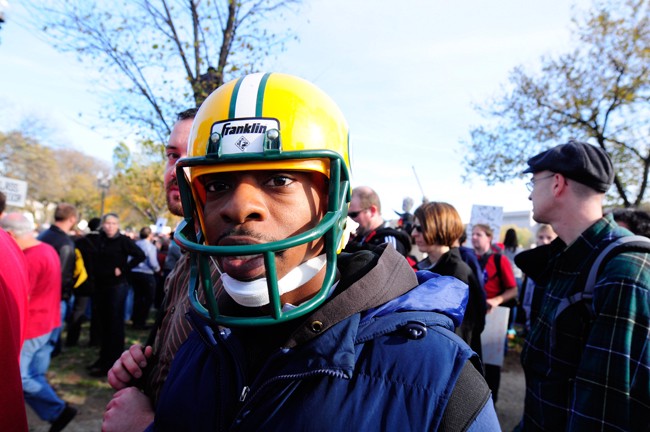


Stephen Kosloff is a photographer in New York.
"Murder Party"
by Sean McTiernan
And now: the final installment in our quirky and bizarre month-long review of the horrorful.
Horror movies are great at illustrating just how awful most human beings are. And not the killers, I mean the victims: whether they be valuing self-preservation over everything (and everyone) else, ignoring the obvious presence of a supernatural menace or marching bravely and directly at seven-foot-tall men with giant machetes. And if you take the daft lack of self-awareness inherent in horror characters (barring our Mike), mix it with the cringe-inducing lack of self-awareness of John Hughes characters and add a huge amount of pretense, what do you have? Art school students.
Murder Party shows art students at their very worst, if such a thing is even possible to capture. Every pompous conversation preys on petty competitiveness and jealously. Bloody as things get, they won’t make you flinch half as much as some of the characters’ vain attempts to curry favor. It’s brutally funny to the point of bitterness and after a month of attempting to give murder and mayhem a deeper meaning, it’s only fitting to end with a movie that mocks that very impulse.
Ostensibly the group in Murder Party have gathered to make some sort of artistic statement. The idea is simple: print one invitation for a Murder Party, release it into the wild and if anyone actually shows up, you can kill them. Each of them has their own ideas about how the death should happen. These range from the ridiculously excessive (“let’s cut his dick off and set him on fire”) to the ridiculously ridiculous (“maybe something more progressive… let’s staple a pancake to his face and push him in front of the G train”). All of this is for the benefit of Alexander, an art patron who recently arrived on the scene, who is impressively cool and capable of giving a lucky artist some serious backing. The Murder Party is a way for the group to compete for Alexander’s affection and, more importantly, his money.
Christopher is a lonely and boring man. His life so exemplifies the word “harmless” that his Halloween costume is a suit of armor made of cardboard. The man even allows his cat to be rude to him. When he finds the invitation to a Halloween party that anyone can attend, he decides with some determination that this will be his attempt to be a bit more social. No prizes for guessing who’s waiting for him at the warehouse or how the fruit loaf he brings will be received.
What follows is such a well-crafted and accurate portrayal of the crazy things people will say and do to confirm their own importance, it almost makes this movie the hardest to watch of any we’ve covered this month. Their self-obsession is all consuming, only equaled by the suffocating desire for Alexander’s approval. Alexander himself plays the preening Special One role to perfection, confusing everyone with his flexible opinions and nonsensical put downs. He also brings his drug dealer to the party, which is always a sure-fire way to raise eyebrows.
This movie has been described as “Breakfast Club with chainsaws and hard drugs” and there really is no better description. Not only does that sum up the excellent writing and accidental emotional truths that characterize Murder Party, it also usefully shows it’s a movie of two parts. Aside from a grisly early surprise, equally shocking in its suddenness and the ease with which it is forgotten, the first half of Murder Party is all talk. The centerpiece of this back and forth is a genius riff on the infamous “Chicks Can Not Hold Their Smoke” conversation in Breakfast Club. Except this time instead of smoking weed, the gang are injected with actual truth serum. Despite some uncomfortable personal revelations (“I make sex with pillow”), the real interesting part of this whole exchange is the questions people ask (“Who’s the best artist?” illicits a “me” from everyone in the room).
Though he’s been mostly a piece of scenery up until that point, poor bound-and-gagged Chris gets his own dose of the truth serum. What he says might be the most interesting stuff of all and definitely the saddest. Whether he’s acknowledging that he thinks his captors are cool (“you guys cuss too much but that’s okay”) or admitting no one would miss him if he were dead, Chris is a quietly heartbreaking character. You even get the sense all his hilariously inept and movie-influenced attempts to escape are motivated by the fear of pain rather than death.
Both horror movies and the art scene come under criticism for their constant drive to be more outrageous and more grisly. While attempting to “break taboos” and fight against normalcy, the characters in the movie reveal themselves to be barely developed as people themselves, full of their own denial and a frighteningly damaged set of priorities.
Oddly for this bawdy and ridiculous a comedy, Murder Party’s violence is actually pretty realistic. And, for once, “realistic” doesn’t just mean getting as forensic as possible. Head wounds especially seem to have been marked out for a more true-to-life treatment than usual, with victims complaining vaguely, cupping the blood flow to stop it staining their clothes and asking if “anyone else smells cut grass?” before keeling over in death. It’s a refreshing take on the usual histrionic way that head-based violence is portrayed.
When Murder Party suddenly kicks off and gives signs of living up to its “Everybody Dies” tagline, it becomes as slyly satirical about horror movie conventions as it is about the art scene. Violence is clumsy and comes mostly from carelessness. Grand gestures are deflated by short power-cables and mislabeled bottles. Special mention must be given to how well the film deflates the whole “disappearing person” trope. If someone is not where you left them, they’re usually quite easy to find, having more likely shuffled “just over there,” rather than disappeared .
It’s a viciously smart horror movie with a lot to say that manages to get it said under 80 minutes. All killer no filler, if you’ll excuse the pun.
And so ends my October run of horror movies. Hopefully you enjoyed it and were maybe encouraged to give some of the lesser known classics of the genre a chance. I’ll be reviewing exploitation and B-movies of every genre, including plenty of horror, over at my blog Zombies Eat Human Flesh starting in November until I run out of time or movies. And I have plenty of both. Happy Halloween.
Sean would like to remind you that really: Zombies Eat Human Flesh.
"Session 9"
by Sean McTiernan
Everything about Session 9 feels wrong. Every moment feels a little off and every exchange of meaningless work banter is loaded with a little more tension than you’d expect. Every shot of an abandoned room or a tree seems to be concealing or foreshadowing. It’s like watching “Friends” without the laugh track: it makes you want to claw your eyes out.
There’s little explanation of what’s going on. For most of the movie’s running time it genuinely appears to be no more than the story of tension between asbestos removal men in an abandoned mental asylum. And it sort of is. There’s no killer or ghost. Except for… something. Something about the way the camera lingers over the long hallways and the filth. The idle conversations the men have about the ex-patients of the asylum and what became of them seem to hold a lot more weight than they should.
As Session 9 progresses, the asylum starts picking away at every member of the crew. Each of their weaknesses become more and more pronounced, as does the gulf between them. The movie lets you know, in little snippets here and there, that something is wrong. The audience is only slightly more aware of what’s going on than the characters. The plot actually becomes less clear as it progresses… until the final ten minutes, which provide not a twist so much as a moment of clarity. When it comes, it feels inevitable. It is the moment when reality must be addressed, no matter how brutal. This movie doesn’t deal in out-of-nowhere shocks: its currency is crushing, suffocating inevitability.
Oddly, Session 9 takes place mostly in daylight (an uncomfortable, dried-blood shade of daylight, but daylight nonetheless). The only conventional horror scene in the film does involve darkness — but not in a way you’d expect. The true source of dread is Danvers Asylum, the genuine mental hospital the movie was filmed in. Danvers is the real deal, with a history of lobotomies, shock-treatments, straight-jackets and general inhumane behavior towards the mentally ill. Usually in horror movies, 1) people arrive in impossibly creepy places, 2) one panicky person is quickly told to shut up, and 3) the rest of the cast remains blissfully oblivious to the theatrical creepiness of their surroundings until a masked man leaps from behind a heavily cobwebbed lampshade and tries to get up in their mix. Not here.
Every room, every area in the asylum, exudes a sort of violent menace. Danvers is so thick with natural atmosphere that it feels as if the depredations performed upon the mentally ill have made themselves part of the surroundings. There’s no discovery of exaggerated torture racks or fetuses in jars, there’s just peeling paint, orange light and pure misery. One shot in particular, of a wheelchair built to restrain patients, is particularly distressing. As the movie progresses and we continue to cut back to this chair it stops being simply a disquieting reminder of the history of the building and becomes something far more terrible: a threat.
Mike, one of the team, discovers audiotapes early on in the movie. They are of a patient named Mary Hobbess, a woman with multiple personality disorder who killed her brother and parents when she was fourteen. Each day we hear Mike listening to more and more tapes. Mary has three other personalities but only two are talking. It quickly becomes clearly they are mortally terrified of the third, Simon, and will not let the doctor speak with him. The tension escalates along with the the tapes. It’s telling that the tapes are, for the lion’s share of the running time, the most overtly scary thing in the movie, when they are simply audio of a woman battling with her own personal demons. These realistic depictions of psychiatric interviews coupled with the footage of the asylum helps the film go deeper inside your head than any normal psychological horror would.
Session 9 is rife with double meaning. From the most obvious, where the men are constantly taking about the “shit” in the building “getting inside them” to the most oblique, where every instruction and accusation made in the last stretch of the movie could apply to the psychology of the characters as well as their literal actions. It is a masterclass in the power of suggestion and the conversational rings people run around each other. None of the men want to admit they have a problem, but all of them suspect the others of approaching the breaking point. They know something is wrong but they can’t verbalize it.
Speaking of awkward, I should tell you David Caruso of “CSI: Miami” infamy is in this movie. This is probably why Session 9 is not widely hailed as a taut masterpiece of psychological horror. But Caruso’s seemingly psychological inability to act is weirdly mimetic in the scheme of the film. Like Caruso’s oddly aggressive lack of talent, Session 9 makes you wildly uncomfortable. It is a movie that wakes the butterflies in your stomach the moment it begins and will soon have you covering your face in fear of seeing another hallway or yellow room. Most importantly, despite some vague hints at supernatural forces, everything you see could actually happen. Worse still: it has.
Sean will continue to review horror movies (and other lost genre classics) at his blog Zombies Eat Human Flesh.
Why Harry Reid's Nevada Field Operation Is Losing
by Natasha Vargas-Cooper
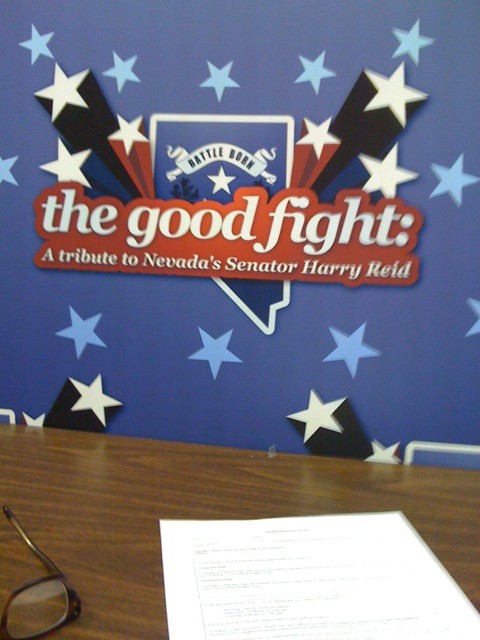
If there’s anything that could save Harry Reid from getting ousted by Sharron Angle on Tuesday, it would be his campaign’s ability to run a competitive ground game: tight coordination of precinct canvassing, disciplined phone banking, targeted literature distribution, quality control over hundreds of volunteers and — above all — clean, up-to-date voter lists.
Based on what I saw yesterday at Democratic Party headquarters in Las Vegas, it’s not happening for Harry Reid.
Here is how Sharron Angle’s field campaign works. Their telephones link up to a Republican voter database. Once a phonebanker has made a contact, she punches a number on the keypad to report whether the person has voted already, how they intend to vote, whether it’s a wrong number or a hang-up. This updates the database in real time. After you disconnect, the phone autodials a new number.
In one hour at Angle HQ, I made 87 phone calls. If I talked to someone who already voted or who told me to “suck off” (true story!), I pressed a button and they were removed from the bank.
The Reid campaign tracks phonebank results by hand. On paper.
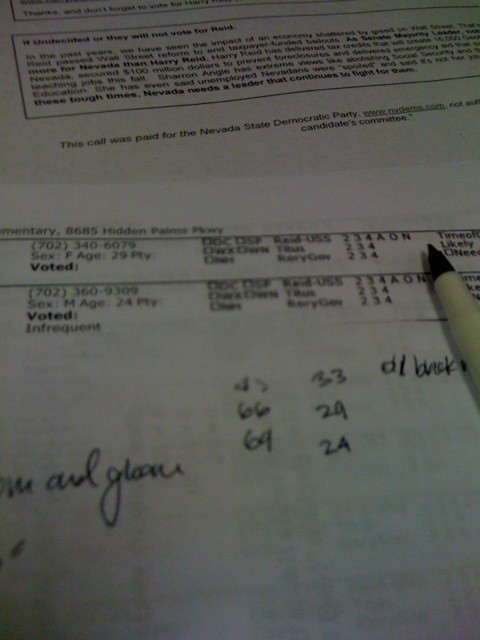
The names and information for about twelve voters are printed on each of the Reid phonebanking sheets. After making a phone call on behalf of “the Democratic party,” we were told to circle whether the voter had supported:
1. Harry Reid as Senator,
2. His son, Rory Reid, for Governor,
3. Dina Titus for Congress.
Some people planed to vote for Harry but not for Rory, so you had to mark a “2” for Harry and a “4” for his son. (Undecideds were a “3.”) If we didn’t get a response because of a busy line or a wrong number, we had to check off one seven tiny boxes ( ‘DC,’ ‘SP,’ ‘WX,’ ‘WN,’ ‘BZ,’ ‘NH’) listed alongside each phone number.
So for insistance, I talked to a Clark County resident who spoke Spanish and intended to vote for Reid but had never heard of his son or Dina Titus. I had to mark this as “2, 3, 3, SP” on my sheet. There’s a bar code next to each voter’s name, so then later campaign workers scan the codes and enter in the data collected.
This was the same method used for the Obama campaign. This sort of data entry takes hours, is easy to mess up, and quickly gets backlogged — thereby keeping people who already voted in the phonebank and house visiting rotation.
At Reid HQ, I made 32 calls in an hour-plus.
* * *

The volunteers seated at the Reid phonebank table were like a diversity brochure come to life: a black lady in her 60s, a young Asian woman, Latino college students, members of the coveted white working class and also an elderly Welshman who had the disposition of a jolly gnome. The campaign staffers are all young, under thirty, and there are a lot of them, on their Bluetooths, in Obama t-shirts and jeans. Two extremely young men came in holding door-to-door canvassing packets. They reported the neighborhoods they canvassed and then have a staffer sign some papers for them.
I chatted with one of the boys. He’s smiley and blushing, wearing skate shoes and t-shirt with distressed, decorative gothic lettering. He’s seventeen years old. “We have to put in ten hours of community service to graduate,” he said. I asked him how it was going door to door. “It was super windy, but it was fun,” he said. We talked about his school’s homecoming and how universally lame homecoming is. Then his ride came to pick him up.
When faced with a voter enthusiasm gap — the kind of dispassion that settles in around a lackluster incumbent in a faltering economy (and, in the case of Harry Reid, a cadaverous temperament) — a campaign’s ability to target infrequent voters and get them to the polls on election day can absolutely change the outcome of a race.
What’s more, Reid has a two-decade legacy of squeaking by in Nevada elections — like in Reid’s congressional bid in 1998, when he beat Republican John Ensign by a few hundred votes.
In most states, getting voters to the polls is a 14-hour operation. For a campaign in Nevada, voting booths are open each day for more than two weeks before the election. So the standards of an effective mobilization campaign are higher in Nevada because there’s a whole other logistic feat to master: tracking people who already voted in order to avoid wasting time and resources. This is usually done by going to precincts and checking the voter rolls. (You’re not allowed to write anything down though, so it’s laborious and inefficient.)
* * *
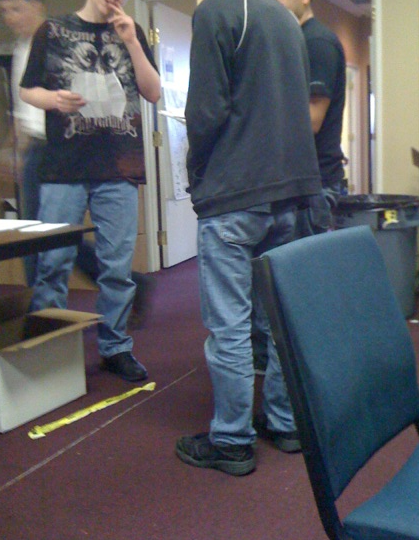
The Democratic headquarters looks a lot like the way it did in during the 2008 presidential election, with one big difference: no momentum. Given the stakes of the race, it was my opinion that the staffers were moving at a surprisingly sluggish rate. Over the course of the day, they deployed and debrief, over and over, but with food-service style enthusiasm. Two years ago, the Obama campaign captain was a 27-year-old sparkplug from Boston who talked, walked and commanded squadrons of volunteers with Sorkin-style speed and precision. Days before the election, it was all delirium and nerves. When people would get burnt out, he would cheerily remind, “This is History we’re doing! History!”
Most of the staffers today are in front of their laptops clicking back and forth between data entry forms and YouTube. The young man overseeing our phonebank called over a female staffer to show her the infamous “Always Be Closing” speech from Glengarry Glen Ross. In between the snatches of “Hi, I’m calling from the Democratic party,” you could hear Alec Baldwin’s throaty voice over the tiny speakers, berating a small group of sad sack real estate hustlers.
Blake: Let’s talk about something important. Put. That coffee. Down. Coffee’s for closers only. You think I’m fucking with you? I am not fucking with you. I’m here from downtown. I’m here from Mitch and Murray. And I’m here on a mission of mercy. Your name’s Levine? You call yourself a salesman, you son of a bitch?
Dave Moss: I don’t gotta sit here and listen to this shit.
Blake: You certainly don’t pal, ‘cuz the good news is — you’re fired. The bad news is — you’ve got, all of you’ve got just one week to regain your jobs starting with tonight.
I used to watch the same clip with fellow campaign staffers when we were attempting to get healthcare reform passed in the first frigid days of Obama’s presidency. We used to repeat the Mamet-penned soliloquy, in private, before big meetings and rallies to get our energy up (it worked much better than any “Si Se Puede” chant). It allowed us to have the kind of naked aggression and bravado that’s usually absent in squishy, lefty, non profits.
“Ok, I’m over this,” the female staffer muttered, as she shuffled off from her inspirational video session. “I have to go to do data entry.”
Natasha Vargas-Cooper is in Nevada through the election — you can reach her via Twitter.
"Pontypool"
by Sean McTiernan
Horror movies are so powerful because of the many different ways artists can spin the archetypes. They aim for the most visceral and basic of reactions, but how they go about getting these responses can be fascinating even when the movie is terrible. Such a pity then that zombies and horror have been assaulted by petty gate-keepers of imagined rules, pounding on their leather back copies of What Zombies Should Do, their mouths frothing at the idea someone has defiled the blessed system and their trousers troubled at the idea of a Zombie Tsar who vets all films for their level of adherence to lore. Horror movies are about fear and repulsion, basic concepts twisted and rethought to be hilarious, terrifying or even both. They don’t deserve to be reduced to debates on WWE message boards about wrestlers breaking Kayfabe.
That’s why it doesn’t matter that Stephanie Meyer never read Dracula by Bram Stoker. It’s not a core text. At this stage, Vampires are an idea and the best thing about ideas is the millions of different ways you can interpret them and still have an instantly recognizable core principle. Now Twilight isn’t good: it’s a horribly written mess of Mormon propaganda. But you shouldn’t be dismiss it because it doesn’t follow a set of rules Bram Stoker and Anne Rice drew up. You should be dismiss it because it’s warping the sexual expectations of millions of young girls as badly as the proliferation of easily-accessible hardcore pornography has warped the sexual expectations of young boys, if to the opposite extreme. Kids love loads of cynically-produced, potentially-damaging, irredeemable crap. That’s why they’re kids and need adults to guide them to cool stuff, even if that usually involves being lame and liking lame stuff, thus driving kids to other thing.
Still, it must be noted that if one iteration of vampires happen to be chaste and sparkly, that doesn’t diminish the meaning or importance of what “traditional vampire fans” (“goths,” if you haven’t the time) enjoy. And it certainly shouldn’t galvanize them into donning their Bauhaus-brand helmets, climbing into their 1978 Volvos of Despair and pulling skids of pedantry all over the internet’s many comment sections. But people love crushing the things they love with dogma and if something they needn’t be paying any attention to deviates in any way, they pounce with the force of a million angry Cradle Of Filth concert-goers who have discovered there are only medium size t-shirts left.
Unlike Twilight, there’s no question of quality when it comes to Pontypool. It’s impossibly well-crafted, tense and original. It also has zombies in it that aren’t called zombies. That’s definitely what they are though. Any movie that calls their mindless hordes anything different is just trying to avoid fanboy nerdrage (but sadly, often creates even more of it).
The significance of zombies isn’t that they’re slow or even really that they used to dead. It’s that they used to be you. Zombies are human beings reduced to their most destructive, mindless incarnation. But they’re still recognizable as humans and that’s the key. Being eaten by zombies, while probably unpleasant, isn’t the most frightening part of the zombie experience. The real terror springs from the idea that other normal people, people you may very well know and love, can tear you apart at any second. And that you could do the same to them. The possibilities for this basic idea are endless. The dangers of consumerism, of crowd mentality, of grief, of anger, of denial… all of these have been illustrated perfectly through the medium of people chewing other people’s faces off.
In Pontypool normal people become murderous, mindless killers through an infection that travels in the English language. The genius of the movie is setting all the action in a small town radio station. Throughout the movie, just enough information is dangled before the cast and audience to let them know hell has come to all around them but leaves them little the wiser as to how or why. Also seeing as the infection travels through language, every person they engage with represents a serious risk.
The host of the show that happens to be on the air is Grant Mazzy, a washed-up shock jock working for a small station who suddenly finds himself at the center of the biggest story in the world. Not only does he wrestle with the same problems as his co-workers, he also finds himself living up to a shock jock’s hype in a way he probably never expected. He literally becomes the lone sane voice in the wilderness. It is also interesting to see him wrestle with being the Good Samartian and realizing that however he acts could make or break his comeback. Vetern character actor Stephen McHattie puts in amazing performance, especially considering most of the time he is acting with a telephone. Although everyone puts in real feeling and great performances, it is he upon whom the movie hinges.
And if this, the story of an odd character trapped in a bizarre situation, sounds like a “Twilight Zone” episode, it should. The minimal budget forces the filmmakers to be cagey with the amount the actually show, leaving them to create most of the horror in the minds of the audience… a classic Serling maneuver. Naturally, this economy of gore and the power of suggestion make the thing a lot more terrifying.
https://www.youtube.com/watch?v=Y1HSNm9GBms
It also probably sounds a lot like a “Twlight Zone” episode because it kind of already is one. Pontypool is not the first story to feature a virus of words. “Need To Know” is an episode of the 1980s version of “Twilight Zone” in which people are being told a ‘secret’ and immediately going insane. The episode concerns the intrepid hero racing to a radio station to stop the secret being broadcast live over the air. This doesn’t lessen the achievement of Pontypool, or make it any less of a unique proposition on today’s horror landscape. All it does is serve to illustrate both how “The Twilight Zone” is the “Simpsons Did It First” of horror and suspense stories, and also how a TV show in the 80s had more original ideas in a season that current horror fare has had in a decade.
There are so many ways zombie movies could be made, and even if Pontypool was an abject failure, its bravery in taking a different tactic in illustrating the infectious and dangerous nature of language would still have been commendable. There’s no need to spelling out the point the movie makes by showing people swept up and turned into maniacs by emotive language all while a small radio station holds the last outpost of sanity steady. The movie lets you figure that out for yourself. Less hand-holding, better acting and more originality… let’s hope Pontypool acts as an example for the next generation of horror to come.
Sean McTiernan has a blog and a Twitter. So does everyone though. He also has a podcast on which he has a nervous breakdown once an episode, minimum. In other words: it’s great for the gym.
John McCain Tries to Embrace Tea Party, Throws Gays (or Bastards!) Under Bus
by Natasha Vargas-Cooper

“I feel like Zsa Zsa Gabor’s fifth husband,” McCain told the crowd last night. “I know what to do but I don’t know how to make it impressive.” This was met with the half-groan, half-clap that you most often hear from a studio audience when a late-night host goes blue. But McCain really was on fire last night! The last time I’d seen him in the flesh was at a last-minute rally, right here in Nevada, the night before he lost the election to Barack Obama. That night he was wooden, humorless and so clearly exhausted that his face had lost its usual malarial tint and was instead a ghostly white.
Last night, it was unclear if Senator McCain’s appearance was the closer of tonight’s rally or if he was perhaps a pitying after-thought of the Angle campaign. McCain took the stage of the Mardi Gras ballroom at the Orleans Hotel following Jon Voight (yes, father of Angelina), Michael Reagan (yes, son of Ronald) and surprise guest Sharron Angle. And at least the wisecrack defused some of the tension that McCain had carried in with him.
Every speaker previous had done their pro-forma Harry Reid/Democrat trashing, but there also exists a real hostility towards the current incarnation of Republican party. Pelosi/Obama/Reid — the “enemies of freedom,” as Michael Reagan put it — were responsible for the country’s problems, both foreign and domestic, that was for sure. But to them, the G.O.P. wasn’t much help either. The vision broadcasted by Angle and company was to restore the country not to its configuration under the Bush administration but back to “Reagan’s America.”
The implication, then, is that McCain is part of the problem.
So when McCain trotted out the talking points on repealing “Obamacare” and fortifying the border, the audience responded more tepidly, withholding the adoring applause they heaped on Angle. McCain only seemed to be accepted by the crowd — made up largely of husband and wife duos over 50 — when he leaned against the podium and cracked jokes about himself like a c-list casino lounge act.
Perhaps sensing that he was getting more by way of shtick instead of stump, McCain doubled down on a gay joke: “A friend of my son’s wanted to join the Marines but he couldn’t because his parents are married.” (This may be a joke about bastards, others who have heard him tell this point out? Huh!)
Once again, a half groan/half clap from the audience filled the ballroom. It was only in the closing moments of the speech that McCain got the crowd’s blood up.
“In the declaration of Independence,” he said, “the words that we hold dear were written: we are endowed by our Creator with certain inalienable rights, that among these are Life, Liberty and the pursuit of Happiness. The Tea Party is all about that!”
The audience roared with approval.
* * *
Sharron Angle gave the President, the senate majority leader and the voting public writ large two words of instruction no fewer than five times during her fifteen minute speech: MAN. UP. While “man up” certainly does not belong to the canon of authentic, spontaneous quips uttered inside the clamor of political arena (see: “You are no Jack Kennedy” and “I paid for this microphone”), it was one of the few material advantages Angle posses over Reid.
Angle is, by far, the candidate with the most virility and verve. “Man up” was such a wonderfully emasculating comment that highlighted the flaccid temperament of the saggy and sleepy-eyed Harry Reid.
It’s a pity she’s already worn out such a potent command. Instead of channeling Hepburn, sounding like an emasculating vamp taking the piss out of an unequally matched sparring partner, she sounded much more like a nagging, fuddy-duddy mother: empty-mindedly spurting a command in lieu of having anything else to say.
* * *
Tonight and tomorrow, the Orleans is a host to a “Halloween Seance” with “renowned medium James Van Praagh.” The crowd will most likely be similar to the Angle event. This audience was grey. Or white, with flecks of liver spots like confetti on their foreheads. Before the magic all began, the two hundred chairs in the Mardi Gras ballroom of the Orleans were filled with modestly dressed folks, the couples quietly chatting to each other before the first pixelated slideshow ran and the lights went low. (The local papers estimated the crowd finally growing to be a thousand people.) Drawings of Thomas Jefferson, Liberty Bell sketches, stock photography of eagles and portraits of centurion men in military garb flashed on two drop-down screens, as someone voice-overed a short biography of America (“I was born in Philadelphia in 1776”).
The events coordinator, Jeri Taylor-Swade of the Angle campaign, then took the stage to congratulate the audience on their efforts to get out the early vote on behalf of Angle. She’s a slim woman in her early forties, in black slacks, a fitted blazer, with her blonde hair pulled back into a neat pony tail.
“I went to get my nails done today,” she told us. “The guy who does my nails is named Tony and I asked Tony if he had voted early.”
Tony did not vote early. Tony forgot to register. She pauses for the crowd’s requisite moan. Then, with her voice cracking in what sounded like genuine dismay, she said: “He was going to vote for Sharron!”
Presented in this way, this perfectly good anecdote leaves people not knowing whether to applaud Tony The Nail Guy’s intentions or to hiss at his poor planning skills. And so they sat there pretty much in silence for a while.
Natasha Vargas-Cooper is in Nevada through the election — you can reach her via Twitter.
At Sharron Angle HQ, Working the Phones: "Do You Trust Harry Reid?"
by Natasha Vargas-Cooper
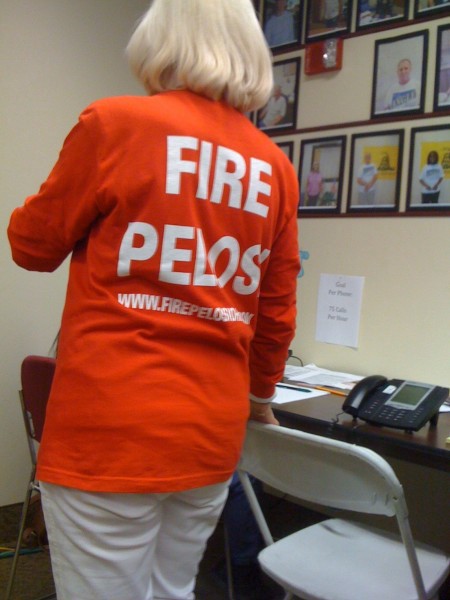
I spent yesterday at Sharron Angle for Senate Campaign Headquarters, in a strip mall in northern Las Vegas. The phonebank volunteers were targeting likely Angle supporters in rural parts of the state to take advantage of early voting, which ended last night. Most of my fellow volunteers (I was, I believe, the only fake volunteer) were over fifty — with the exception of Summer and Jordan, two bubbly seventeen-year-olds who both had family in the military — and white and not originally from Nevada. By coincidence, the three women in my adjoining cubby were from all from Pennsylvania, having moved to Nevada after their children were grown. The ladies, with their various shades of silver hair, would take a few minutes between phonecalls to gab, mostly about Social Security: how much they were getting, where it was all going and the general future of the entitlement program.
“I told my daughter not to even dream of relying on it! It will be all spent — on bridges, or planting trees, or whatever! — by the time it’s her turn,” one of the ladies, Loretta, said, as the others nodded in solemn agreement.
I know these women and their lack of scariness is what makes them so damn scary. They are neither devils nor crazies, necessarily. These are angry, modest white people who are pouring their frustrations into an abysmal candidate. When I was a union organizer working in Nevada, it was these sort of women — the fired up, pissed off, anxious about the future types who were the most willing to pick a union fight. In a different context, it’s easy to picture myself working alongside them trying to fight the sort of employers that liquidated worker pensions.
“We’re fighting the good fight!” said one of the ladies. She has a wet smoker’s cough and chuckled out loud after getting abruptly hung up on by a Reid supporter. She was emboldened for her next call, in which she hurriedly introduced herself as a volunteer for the Sharron Angle campaign, and immediately asked: “Are you happy with the country? Do you trust Harry Reid to fix it? I don’t!”
On the phones, the ladies were getting the most traction with a message that resonated here in Nevada two years ago: hope and change. In other words, anyone who is unhappy with the current way things are going in the country — and Nevada has quite a bit to be unhappy about, with a 22.3% “actual” unemployment rate and the highest rate of foreclosures in the country — then Sharron Angle offers an opportunity to “do things differently.”
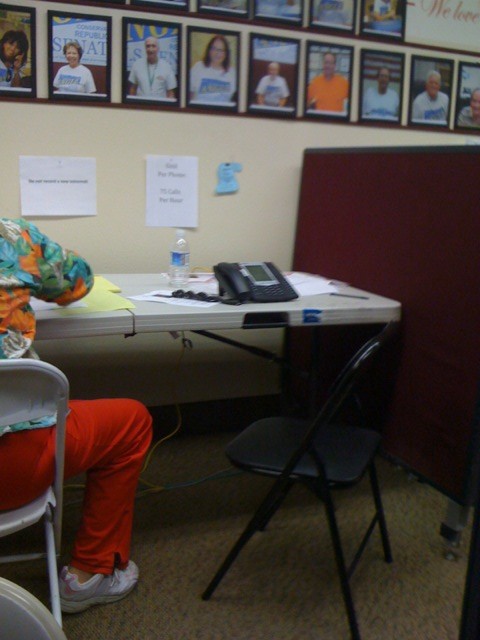
This close to election day, the majority of people we reach on the phones have already made up their minds about who they want to be the next senator of Nevada. For the few undecided, the ladies will mention how expensive “’Obamacare’ has made medical treatment” and how Angle wants to keep “Social Security in a locked box.”
As is typical with the final push phonebank of these type, there’s very little discussion of Sharron Angle. Instead, a favorite tidbit on the phones, one that was not a part of our official script, was discussing Obama’s just announced, first-ever two-day trip to India on November 6th.
“He’s staying at the Taj Majal!” Lorretta, three hours into her shift, said. “Boy, I’d sure like to take a vacation and stay at a palace! Wouldn’t you?”
Then she encouraged those she reached to “watch Fox News!” and “turn on Glenn Beck! He’ll tell you the truth.”
I don’t know even know what the counterpoint would be for the Reid campaign. “Watch Rachel Maddow, she’ll tell you the truth”? You could point to the Stewart/Colbert rally as some kind of contrast but from here, those rallies just seem like some therapeutic get-together for people who wish to repudiate Glenn Beck and his influence on Loretta. Or is it just against the Lorettas of our country? Everyone’s angry, and everyone needs somewhere to go.
Natasha Vargas-Cooper is in Nevada through the election — you can reach her via Twitter.
A Week of Hysteria Crashes Hard

We investigated lady-related scifi visions of the future that may or may not work out.
We checked in with “Boardwalk Empire” at its halfway point.
We looked, with great yearning, toward what would come after this bloody horrid election.
We followed a spectacular contestant in the Apollo’s famous amateur competition.
We got a smartass baby sister to go along with our joke- and poop-obsessed younger brother.
Of course the award for most-commented-upon post of the week goes to a conversation about political candidate Christine O’Donnell.
Hey! So let’s meet back here on Monday to count how many children we’ve each stolen on Sunday night and how much sanity you’ve accumulated by your big march on Washington. (For those staying home, pro tip: pretty much everyone reports that you shouldn’t miss “Walking Dead” on Sunday night, if you’re into TV about zombies, which, you are.)
I Would Buy the Living Hell Out of this $62,000 Hermes Motorcycle

You know what, YES, thank you for asking, I would very much like to buy your $62,000 Hermes-Yamaha motorcycle! That motorcycle 110% makes me not give a fuck about starving children and unemployment and ever-increasing financial inequity and bullshit like books! I would buy the shit out of that and then the newspapers could all die and then I would go buy one more for my exceedingly limber masked accomplice and then we would go out and get some In-n-Out Burgers and adopt every unadoptable FIV kitten in the no-kill shelter system and stuff them all in our sidecars and get on our Hermes bikes and be all VROOM VROOM, riding down the back streets, oh yeah: THE WOLF IS HUNGRY, HE RUNS THE SHOW! Then we’d end up in some parking lot in Berlin where we’d have some truly risque outercourse with other really rich people on top of our motorcycles, like it was some Czech porno time travel exploitation film but we were really living it! You know, like in Xanadu. That’s what devotion to a lifestyle brand is all about. You poseurs.
